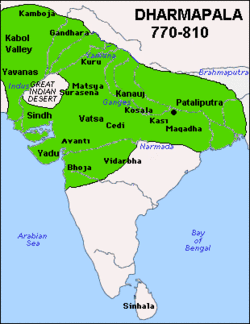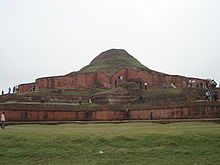- Dharmapala (emperor)
-
Pala Empire
পাল সাম্রাজ্য770–810 Dharma Pala's empire at its greatest extent. Capital Pataliputra Religion Buddhism Government Monarchy History - Established 770 - Disestablished 810 Dharama Pala (Bengali: ধর্মপাল Dhôrmopal) (rule: 770 AD – 810 AD) was the second ruler of the Pala Empire of Bengal region in the Indian Subcontinent. He was the son and succeessor of Gopala (rule: 750 AD – 770 AD), the founder of the Pala Dynasty. He greatly expanded the boundaries of the Pala Empire founded by his father and made the Palas the most dominant power in the northern and eastern Indian subcontinent. He was succeeded by his son Devapala who further expanded the empire.
Contents
Military career
When Dharmapala ascended the throne of Bengal, the political horizon was very gloomy.[1] At the very outset, Dharmapala was locked in severe power struggle with the Gurjara Pratiharas of Malwa and Rajputana as well as the Rashtrakutas of the Deccan who were both desirous of establishing their own hegemony over northern India.[2] So, shortly he was involved in cut-throat power struggle with them. Dharmapal defeated the Pratihara king Indraraja or Indrayudha of Kanauj and deposed him, and placed Chakrayudha on the throne of Kanauj.[3] It is pointed out that Dharmapala had held a court in Kanauj after this victory which was attended by rulers from Bhoja (Berar), Matsya (Jaipur), Madra (Central Punjab), Kuru (Thaneswar), Yadu (Mathura & Dwaraka), Avanti (Malava), Yavana, Gandhara (Kabol valley = Kamboja) and Kira (Kangra).[4] These chiefs not only approved of his military action but also paid respectful obeisance to him.[5] It seems that Dharmapala had made himself the supreme leader in of Northern India since he calls himself as Uttarapathasvamin or Lord of Northern India.[6]
Later, however, Dharmapala was defeated by Vatsaraja of the Pratihara dynasty who deprived him of the Gaur. But Vatsaraja himself was soon defeated by King Dhruva of the Rashtrakutas who later also clashed with Dharmapala and defeated him but Dhruva soon left for Deccan and thus Dharmapal did not lose much in this quick chain of events, but these events had left the Pratiharas badly mauled which indirectly helped Dharmapala. He fully availed this golden opportunity and truly made himself the Lord of Northern India (Uttarapathasvamin).
Later, Nagabhata II of Gurjara Pratihara had deposed Chakrayudha of Kannauj, a protégé of Dharmapala, which event brought Dhrampala into military conflict with Nagabhata II at Monghyr. Dharmapala suffered a defeat but curiously enough, history repeated itself and Pratihara ruler Nagabhata was himself soon knocked out by Govinda III of the Rashtrakuta dynasty.
The invasion by Nagabhata was of transitory nature and did not leave any permanent mark so Dharamapala practically retained the supreme power in North till the end of his life.
Sphere of Influence
Somapura Mahavihara is the greatest Buddhist Vihara in the Indian Subcontinent built by Dharmapala; it became a World Heritage Site in 1985.
Dharamapala had full control of Bengal and Bihar. Kingdom of Kanauj was his feudatory.[7] The kingdoms of Madra, Kamboja/Gandhara, Rajputana, Malava and Berar were vassal states which paid him tributes and acknowdged his mastery over them. Even Nepal is said to have been his vassal state.[8] The strong influence of Indian art(Buddhist) in eastern Iran has been noted by R.N. Frye [9] Sandhyakar Nandi, a court poet of later Palas, states that the Pala dynasty belonged to Samudrakula or Ocean lineage.[10] The Kamauli Grant of king Vaidyadeva of Assam also connects the Palas to Mihirasya vamsa or 'Surya lineage' (Sun/Fire worshipers).
Religious leanings
Dharmapala was a great patron of Buddhism. He revived the Nalanda university and founded the Vikramshila university which later evolved into a great learning center of Buddhism.[11] He built the great Vihara at Somapuri in Verendri, Vihara in Paharpur and a splendid monastery at Odantapuri in Bihar. He is said to have founded fifty religious schools for the teachings of Buddhism.[12] He patronised the Buddhist author Haribhadra.
Successor of Dharmapala
Dharmapala had ruled for about 40 years and was succeeded by his son Devapala (rule: 810 AD - 850 AD) who further expanded the frontiers of Pala empire.
See also
References
- ^ The Age of Imperial Kanauja, History and Culture of Indian People, 1964, p 45, Dr R. C. Majumdar, Dr A. D. Pusalkar.
- ^ http://www.lotussculpture.com/pala.htm
- ^ http://www.lotussculpture.com/pala.htm
- ^ http://encyclopedia.farlex.com/Pala+Empire
- ^ Ancient India, 2003, p 648, Dr V. D. Mahajan.
- ^ Ancient India, 2003, p 648-49, Dr V. D. Mahajan.
- ^ http://encyclopedia.farlex.com/Pala+Empire
- ^ Syayambhu Purana; Ancient India, 2003, p 649, Dr V. D. Mahajan.
- ^ "The Golden Age of Persia", p.41
- ^ http://encyclopedia.farlex.com/Pala+Empire
- ^ http://www.nalanda-monastery.org/
- ^ Ancient India, 2003, p650, Dr V. D. Mahajan.
Further reading
- Pankaj Tandon: "A Gold Coin of the Pala king Dharmapala," Numismatic Chronicle, No. 166, 2006, pp. 327-333.
- History and Culture of Indian People, The Age of Imperial Kanauj, p 44, Dr Majumdar, Dr Pusalkar
- Ancient India, 2003, Dr V. D. Mahajan
External links
Preceded by
GopalaPala Emperor
770–810 CESucceeded by
DevapalaCategories:- Former monarchies of Asia
- Former countries in Asia
- 810 deaths
- Pala kings
- Rulers of Bengal
Wikimedia Foundation. 2010.


